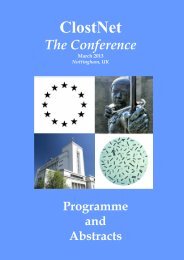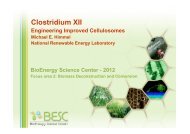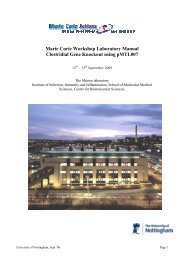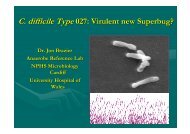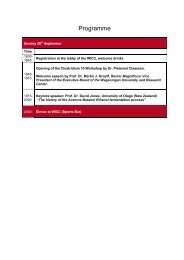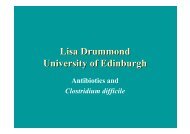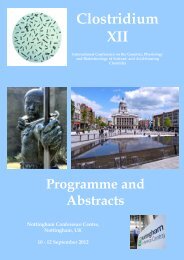abstract book - Clostridia
abstract book - Clostridia
abstract book - Clostridia
Create successful ePaper yourself
Turn your PDF publications into a flip-book with our unique Google optimized e-Paper software.
ANIMAL BOTULINUM TOXICOSES: THE GERMAN EXPERIENCES<br />
H. Böhnel 1 , F. Gessler 2<br />
1 Institute for Tropical Animal Health, Georg-August-University,<br />
Göttingen<br />
2 Miprolab GmbH, Göttingen, Germany<br />
Clostridium botulinum is known as an anaerobe bacterium, producing<br />
spores and highly toxic metabolites (BoNT). Since about 100 years the<br />
disease “botulism” is known. Every text<strong>book</strong> features<br />
• Intoxication, soil borne disease<br />
• Sudden onset, muscular paralysis, final death due to<br />
suffocation<br />
• Different susceptibility of different animal species including man<br />
In recent years there is evidence for an increasing number of cases of<br />
infection in man and animals. Almost nothing is known on chronic<br />
resorption/action of minute amounts on BoNT.<br />
Following thousands of treated samples in our diagnostic laboratory we<br />
report several features of C. botulinum infection in animals and man<br />
• Visceral botulism in cattle and pigs<br />
• Grass sickness in horses<br />
• Sudden infant botulism<br />
• BoNT and bovine mastitis<br />
• BoNT and right abomasal displacement<br />
• BoNT and tonsils<br />
• BoNT and diabetes<br />
• BoNT and decubitus<br />
Vaccination of animals is a promising means of prevention. The<br />
catastrophic situation to obtain vaccines as an example in Germany will<br />
be explained.<br />
21



